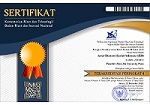Partial Analysis of Mudharabah Financing on the Profitability of the Sharia Commercial Banks in Indonesia
Abstract
Keywords
Full Text:
PDFReferences
Ansori, A. G. (2009). Perbankan Syariah di Indonesia. Gadjah Mada University Press.
Inayati, I. (2018). Pengaruh Pembiayaan Mudharabah Terhadap Profitabilitas (ROE) Studi Bank Syari’ah Mandiri Periode 2008-2017. UIN Sultan Maulana Hasanuddin Banten.
Indonesia, I. B. (2014). Mengelola Bisnis Pembiayaan Bank Syariah. PT. Gramedia Pustaka Utama.
Ismail. (2011). Perbankan Syariah. Kencana Prenadamedia Group.
Karim, A. (2010). Perbankan Islam Analisis Fiqih dan Keuangan. PT. Raja Grafindo Persada.
Khan, M. F. (1995). Essay in Islamic Economics (Economic S). The Islamic Foundation.
Pemata, R. Inti Dwi; Yaningwati, F. (2014). Analisis Pengaruh Pembiayaan Mudharabah dan Musharakah Terhadap Tingkat Profitabilitas (Return on Equity) (Studi pada Bank Umum Syariah yang terdaftar di Bank Indonesia Periode 2009-2012). Jurnal Administrasi Dan Bisnis, 12(1), 1–9.
Nugroho, L., Suganda, A. D., Febrianty, F., Labetubun, M. A. H., Ihwanudin, N., Trimulato, T., ... & Anwar, A. (2020). PENGANTAR PERBANKAN SYARIAH.
Presiden Republik Indonesia. (1998). Undang-Undang Republik Indonesia Nomor 10 Tahun 1998 Tentang Perubahan Atas Undang-Undang Nomor 7 Tahun 1992 Tentang Perbankan. Presiden Republik Indonesia, 63.
Sartika, D. (2010). Analisis Pengaruh Ukuran Perusahaan, Kecukupan Modal, Kualitas Aktiva Produktif dan Likuditas Terhadap Return on Assets (ROA) Studi Kasus Pada Bank Umum Syariah di Indonesia Periode 2006-2010.
Chasanah, N. U., Ilmiah, D., & Rahmatika, A. N. M. (2020). Penerapan Akad Ijarah Muntahiya Bittamlik (IMBT) di Bank BRI Syariah KCP Jombang. REVENUE Jurnal Ekonomi Pembangunan dan Ekonomi Syari'ah, 2(01), 47-56.
Masykuroh, N., Suganda, A. D., Sani, A. A., Fasa, M. I., & Rahmanto, D. N. A. (2020). Cycle Business on Islamic Bank: Var Approach. Journal of Talent Development and Excellence, 12(3s), 1165-1175.
Rahmanto, D. N. A., Fasa, M. I., & Rijal, K. (2020). Source of funds and Islamic insurance growth: investment returns as a mediation. al-Uqud: Journal of Islamic Economics, 4(1), 104-114.
Purbowisanti, R. (2020). Penerapan ARCH/GARCH untuk Meramalkan Volatilitas Reksa Dana Campuran Syariah Dan Reksa Dana Campuran Konvensional. At-tijaroh: Jurnal Ilmu Manajemen dan Bisnis Islam, 6(2), 132-146
Sugiyono. (2015). Metode Penelitian Kuantitatif Kualitatif dan R&D. Alfabeta.
DOI: http://dx.doi.org/10.21927/jesi.2021.11(2).87-91

This work is licensed under a Creative Commons Attribution-ShareAlike 4.0 International License.












